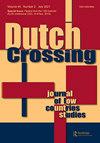IF 0.4
3区 历史学
Q1 HISTORY
Dutch Crossing-Journal of Low Countries Studies
Pub Date : 2021-01-02
DOI:10.1080/03096564.2021.1875311
引用次数: 0
摘要
首先,我们要感谢我们的读者、作者和评论家对《荷兰穿越》新版式的积极反馈。它肯定了我们杂志所取得的进步,并鼓励我们沿着这条道路继续前进。向新发行商Maney的过渡进行得很顺利,我们与他们的专业关系也发展得很好。在密切的合作伙伴关系下,我们将继续推动杂志的发展,不仅寻求加强其作为青年和资深学者论坛的作用,而且还将扩大我们的读者群,超越其传统受众,反映《荷兰穿越》的跨学科和跨国方向,以及低地国家在英语、法语和德语文化之间的十字路口的地位。显然,并非每一期《荷兰十字》都能涵盖所有方面。尽管如此,目前的数字反映了我们读者兴趣的多样性和低地国家研究的丰富性。Hentie low(纽卡斯尔)通过考察17世纪末和18世纪初英国和荷兰共和国在建筑领域的文化交流打开了这个问题本文章由计算机程序翻译,如有差异,请以英文原文为准。
Lectori Salutem
We would like to begin this issue by thanking our readers, authors and reviewers for the very positive feedback that we had on the new format of Dutch Crossing. It confirms the progress our journal has made and encourages us to go ahead along this path. The transition to the new publisher, Maney, went smoothly and our professional relationship with them is developing very promisingly. In close partnership, we continue to take the journal forward and will seek to strengthen not only its role as a forum for both younger as well as senior scholars, but to reach out and expand our readership beyond its traditional audiences, reflecting both the interdisciplinary and transnational direction of Dutch Crossing and the position of the Low Countries at the crossroads between the Anglophone, Francophone and German-speaking cultures. Obviously, not every aspect can be covered in every issue of Dutch Crossing. Still, the current number reflects the diversity of interests of our readership and the richness of Low Countries studies. Hentie Louw (Newcastle) opens the issue by examining the cultural exchanges in the field of architecture between Britain and the Dutch Republic in the late 17 th and early 18 th
求助全文
通过发布文献求助,成功后即可免费获取论文全文。
去求助

 求助内容:
求助内容: 应助结果提醒方式:
应助结果提醒方式:


